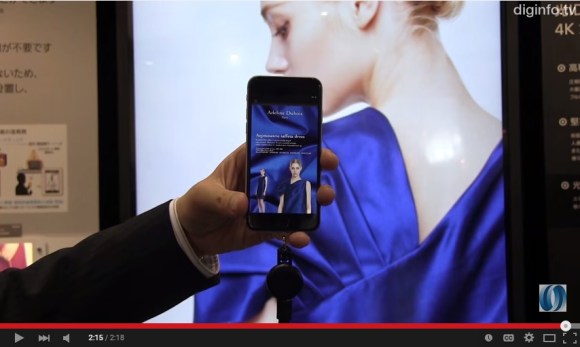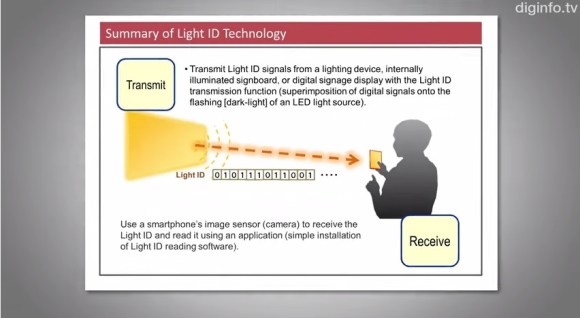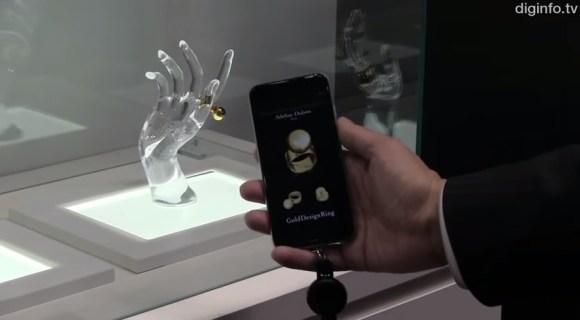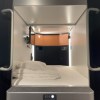
There are many ways that data is transferred these days, be it fiber optic cables, Wi-Fi, Bluetooth, 4G-LTE, and a whole slew of other brand names and acronyms the meanings of which I don’t care to learn.
Now Panasonic has come up with a way to send and receive data that’s easy for everyone to understand: light. Actually it uses light emitting diodes (LED) to be exact, but that’s about as technical as this explanation needs to get, I promise.
The news comes via DigInfo TV who interviewed a rep from Panasonic. Basically, the light of an LED can flicker on and off in a pattern that can be detected by a sensor such as your smartphone’s camera. It works kind of like Morse code but with light…and that’s it really.
You might be wondering why no one else has thought of this before given how simple it is. Actually lots of people have, but this technique had a lot of limitations for everyday use. The tricky part is in the timing of the flicker.
If you flick the light on and off incredibly fast, you can send lots of data quickly and the human eye would never notice it. However, a smartphone camera wouldn’t be able to notice it either and you’d have to get a separate specialized device which would be a drag.
The other way, you could slow down the flicker so that a smartphone could catch the code. But then your brain would be able to as well, and might lead to eye-irritating signs that would make city streets look like a scene from Captain Power.
▼ For the younger folk who might not know Captain Power. For those who do, get your guns ready!
What Panasonic did was find that sweet spot that is undetectable by the human eye but also just enough of a contrast for a smartphone to catch. One of their tricks was simply adjusting the brightness levels rather than turning the light completely on or off.
▼ Although the ad simply says “Adeline Dubois,” those interested can get more info delivered from the sign’s light to their smartphone.
Although very simple in design, the range of applications for this method is very wide. Of course, any LED illuminated signboard could be used to send product information instantly to your phone. For example, simply pointing your smartphone at a movie poster could start up a full trailer of it to help you decide if you want to watch it. This could also considerably free up space in advertising design needed to provide information.
Also for travelers in foreign lands, pointing your phone at an illuminated sign written in, say, Japanese could instantly transmit a translated version of it in your own language. The sign itself doesn’t even have to provide the light. For example, the ambient LED light of a restaurant could contain the data for versions of their menus in different languages or the nutritional information for each dish.
▼ The light illuminating the ring on display also transmits the name and maker of it to the smartphone.
If this system gets picked up by other companies and government then we could be looking a future that’s not exactly bright but slightly dimmer and flickering.
Source: DigInfo TV (English/Japanese)
Video: YouTube – DigInfo TV, ASISHIN




 KFC Japan creates new fried chicken eating gloves to keep grease off your hands and smartphone
KFC Japan creates new fried chicken eating gloves to keep grease off your hands and smartphone LED plant factories offer efficient 3D alternative to traditional gardening
LED plant factories offer efficient 3D alternative to traditional gardening Future Alert: In 2015 you’ll be able to use your smartphone to brush your teeth, kind of
Future Alert: In 2015 you’ll be able to use your smartphone to brush your teeth, kind of Japanese foundation tests mobile meditation truck in Osaka city with promising results
Japanese foundation tests mobile meditation truck in Osaka city with promising results This ‘Wonder Material’ Could Make Your Next Phone Super Thin With Internet That’s 100x Faster
This ‘Wonder Material’ Could Make Your Next Phone Super Thin With Internet That’s 100x Faster Beautiful new Final Fantasy T-shirt collection on the way from Uniqlo【Photos】
Beautiful new Final Fantasy T-shirt collection on the way from Uniqlo【Photos】 Disney princesses get official manga makeovers for Manga Princess Cafe opening in Tokyo
Disney princesses get official manga makeovers for Manga Princess Cafe opening in Tokyo Randomly running into a great sushi lunch like this is one of the best things about eating in Tokyo
Randomly running into a great sushi lunch like this is one of the best things about eating in Tokyo Is the new Shinkansen Train Desk ticket worth it?
Is the new Shinkansen Train Desk ticket worth it? We tried Japan’s Strawberry Daifuku? liqueur, one of three dessert-themed liqueurs
We tried Japan’s Strawberry Daifuku? liqueur, one of three dessert-themed liqueurs New Studio Ghibli bedding sets are cool in all senses of the word
New Studio Ghibli bedding sets are cool in all senses of the word Foreign English teachers in Japan pick their favorite Japanese-language phrases【Survey】
Foreign English teachers in Japan pick their favorite Japanese-language phrases【Survey】 Is Starbucks Japan’s new Gohobi Melon Frappuccino really the ultimate melon Frappuccino?
Is Starbucks Japan’s new Gohobi Melon Frappuccino really the ultimate melon Frappuccino? This northern Tokyo capsule hotel is cheap, clean, comfortable, and has amazing amenities
This northern Tokyo capsule hotel is cheap, clean, comfortable, and has amazing amenities J-pop megastar Utada Hikaru releases new video and recording of “Traveling”【Video】
J-pop megastar Utada Hikaru releases new video and recording of “Traveling”【Video】 We try out “Chan Ramen”, an underground type of ramen popular in the ramen community
We try out “Chan Ramen”, an underground type of ramen popular in the ramen community Our Japanese reporter visits Costco in the U.S., finds super American and very Japanese things
Our Japanese reporter visits Costco in the U.S., finds super American and very Japanese things New Pokémon cakes let you eat your way through Pikachu and all the Eevee evolutions
New Pokémon cakes let you eat your way through Pikachu and all the Eevee evolutions There’s a park inside Japan where you can also see Japan inside the park
There’s a park inside Japan where you can also see Japan inside the park Japanese convenience store packs a whole bento into an onigiri rice ball
Japanese convenience store packs a whole bento into an onigiri rice ball Hanton rice — a delicious regional food even most Japanese people don’t know about, but more should
Hanton rice — a delicious regional food even most Japanese people don’t know about, but more should Final Fantasy, Kingdom Hearts, and Dragon Quest pet product line announced by Square Enix
Final Fantasy, Kingdom Hearts, and Dragon Quest pet product line announced by Square Enix Studio Ghibli releases Kiki’s Delivery Service chocolate cake pouches in Japan
Studio Ghibli releases Kiki’s Delivery Service chocolate cake pouches in Japan Japan’s bone-breaking and record-breaking roller coaster is permanently shutting down
Japan’s bone-breaking and record-breaking roller coaster is permanently shutting down New definition of “Japanese whiskey” goes into effect to prevent fakes from fooling overseas buyers
New definition of “Japanese whiskey” goes into effect to prevent fakes from fooling overseas buyers Foreign passenger shoves conductor on one of the last full runs for Japan’s Thunderbird train
Foreign passenger shoves conductor on one of the last full runs for Japan’s Thunderbird train Kyoto bans tourists from geisha alleys in Gion, with fines for those who don’t follow rules
Kyoto bans tourists from geisha alleys in Gion, with fines for those who don’t follow rules Studio Ghibli unveils Mother’s Day gift set that captures the love in My Neighbour Totoro
Studio Ghibli unveils Mother’s Day gift set that captures the love in My Neighbour Totoro Domino’s Japan now sells…pizza ears?
Domino’s Japan now sells…pizza ears? Toyota built a life-sized Miraidon Pokémon and are letting people test drive it this weekend
Toyota built a life-sized Miraidon Pokémon and are letting people test drive it this weekend New Japanese KitKat flavour stars Sanrio characters, including Hello Kitty
New Japanese KitKat flavour stars Sanrio characters, including Hello Kitty Sales of Japan’s most convenient train ticket/shopping payment cards suspended indefinitely
Sales of Japan’s most convenient train ticket/shopping payment cards suspended indefinitely Sold-out Studio Ghibli desktop humidifiers are back so Totoro can help you through the dry season
Sold-out Studio Ghibli desktop humidifiers are back so Totoro can help you through the dry season Japanese government to make first change to romanization spelling rules since the 1950s
Japanese government to make first change to romanization spelling rules since the 1950s Ghibli founders Toshio Suzuki and Hayao Miyazaki contribute to Japanese whisky Totoro label design
Ghibli founders Toshio Suzuki and Hayao Miyazaki contribute to Japanese whisky Totoro label design Doraemon found buried at sea as scene from 1993 anime becomes real life【Photos】
Doraemon found buried at sea as scene from 1993 anime becomes real life【Photos】 Tokyo’s most famous Starbucks is closed
Tokyo’s most famous Starbucks is closed One Piece characters’ nationalities revealed, but fans have mixed opinions
One Piece characters’ nationalities revealed, but fans have mixed opinions We asked a Uniqlo employee what four things we should buy and their suggestions didn’t disappoint
We asked a Uniqlo employee what four things we should buy and their suggestions didn’t disappoint Princesses, fruits, and blacksmiths: Study reveals the 30 most unusual family names in Japan
Princesses, fruits, and blacksmiths: Study reveals the 30 most unusual family names in Japan Studio Ghibli’s new desktop Howl’s Moving Castle will take your stationery on an adventure
Studio Ghibli’s new desktop Howl’s Moving Castle will take your stationery on an adventure A better use for your smartphone than Angry Birds: Remotely driving your car!
A better use for your smartphone than Angry Birds: Remotely driving your car! Should you drive through a red traffic light like this in Japan? Confusing road rule explained
Should you drive through a red traffic light like this in Japan? Confusing road rule explained Step inside a mystical, dazzling display of illuminations at the Flower Garden of Lights
Step inside a mystical, dazzling display of illuminations at the Flower Garden of Lights Glowing skirt lets you cosplay Hatsune Miku, show off your sexy thighs
Glowing skirt lets you cosplay Hatsune Miku, show off your sexy thighs REVIEW: Samsung’s new fitness gadget makes a sleek smartwatch
REVIEW: Samsung’s new fitness gadget makes a sleek smartwatch See Tokyo’s holiday illuminations from the comfort of a taxi with the Tokyo Night Cruise
See Tokyo’s holiday illuminations from the comfort of a taxi with the Tokyo Night Cruise Tokyo Skytree to light up as three traditional Japanese meals in honour of “Washoku Day”
Tokyo Skytree to light up as three traditional Japanese meals in honour of “Washoku Day” Tokyo University and NHK on the verge of touch-o-vision: Television you can truly feel a part of
Tokyo University and NHK on the verge of touch-o-vision: Television you can truly feel a part of Japanese police to introduce video function to emergency 110 calls
Japanese police to introduce video function to emergency 110 calls The world’s first smart umbrella is the last umbrella you’ll ever lose!
The world’s first smart umbrella is the last umbrella you’ll ever lose! Meowrse code: when you want to send an SOS filled with cute cats
Meowrse code: when you want to send an SOS filled with cute cats Sagamiko Illumillion Christmas light park opening soon, promises glittering Pokémon, light shows
Sagamiko Illumillion Christmas light park opening soon, promises glittering Pokémon, light shows New Sailor Moon illumination event will bring Crystal Tokyo…or rather Crystal Kanagawa to life
New Sailor Moon illumination event will bring Crystal Tokyo…or rather Crystal Kanagawa to life New train ad in Japan advocates for leaving texts a while without a response, sparks debate
New train ad in Japan advocates for leaving texts a while without a response, sparks debate Become an official supporter of the Evangelion smartphone, going on sale this year!
Become an official supporter of the Evangelion smartphone, going on sale this year!
Leave a Reply